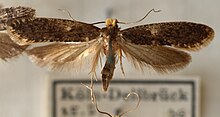Monopis laevigella, the skin moth, is a species of tineoid moth. It belongs to the fungus moth family (Tineidae), and therein to the nominate subfamily Tineinae. It is (under its junior synonym Tinea rusticella) the type species of the genus Monopis and its junior objective synonym Hyalospila. As with the common clothes moth (Tineola bisselliella), earlier authors frequently misapplied the name Tinea vestianella to the present species.[1]
| Monopis laevigella | |
|---|---|

| |
| Adult specimen | |

| |
| Adult specimen | |
| Scientific classification | |
| Domain: | Eukaryota |
| Kingdom: | Animalia |
| Phylum: | Arthropoda |
| Class: | Insecta |
| Order: | Lepidoptera |
| Family: | Tineidae |
| Genus: | Monopis |
| Species: | M. laevigella
|
| Binomial name | |
| Monopis laevigella (Denis & Schiffermüller, 1775)
| |
| Synonyms | |
|
Numerous, see text | |
It is not uncommon all across western Palearctic as well as in North America[2]. It has not been recorded in Slovenia yet, but given that it occurs in all neighboring countries, it probably has simply been overlooked. Its absence from some Mediterranean islands may be genuine however.[3]
Description and ecology
editThe adults of this small moth have a wingspan of 13–20 mm. On the wing around May to September (depending on the location), they are nocturnal and come out at dusk. They have dark brown forewings with a white fringe and the translucent center spot characteristic for the genus Monopis, but lack the white markings adjacent to it found in many congeners. The hindwings are lighter brown-grey; they are surrounded by a long-haired fringe, as usual for fungus moths and relatives. The body is dark brown, and the head bears a tuft of reddish-ochre hair.[4] [5]
Two generations per year may occur as far north as southern England. Otherwise, the caterpillar larvae are found in the colder months only. They generally feed on animal detritus. They have been recorded from dried-out animal carcasses, in the debris of bird nests and on owl pellets. They have also been found to eat feathers, furs, hairs, carpets, rags and rotted fabrics.[6]
Synonyms
editInvalid scientific names (junior synonyms and others) of the skin moth are:[7]
- Blabophanes semispilotella Strand, 1900
- Monopis rusticella (Hübner, 1796)
- Monopis saturella (Haworth, 1828)
- Recurvaria rustica Haworth, 1828 (unjustified emendation)
- Tinea laevigella Denis & Schiffermüller, 1775
- Tinea rusticella Hübner, 1796
- Tinea saturella Haworth, 1828
- Tinea vestianella (sensu auct., non Linnaeus, 1758: preoccupied)
Blabophanes semispilotella has been believed to refer to the same animal as M. weaverella, but the latter seems to be a distinct species, while the former is not even a subspecies of M. laevigella but merely a chance form.[8]
Footnotes
edit- ^ Pitkin & Jenkins (2004), ABRS (2008), Robinson [2010]
- ^ Boone, Mike. "Monopis laevigella – ([Denis & Schiffermüller], 1775)". Moth Photographers Group at the Mississippi Entomological Museum at the Mississippi State University.
- ^ FE (2009), Kimber [2010]
- ^ Kimber [2010]
- ^ Reinhard Gaedike, 2019 Tineidae II : Myrmecozelinae, Perissomasticinae, Tineinae, Hieroxestinae, Teichobiinae and Stathmopolitinae Microlepidoptera of Europe, vol. 9. Leiden : Brill
- ^ Grabe (1942), Kimber [2010]
- ^ Robinson [2010]
- ^ Robinson [2010]
References
edit- Australian Biological Resources Study (ABRS) (2008): Australian Faunal Directory – Monopis. Version of 2008-OCT-09. Retrieved 2010-MAY-09.
- Fauna Europaea (FE) (2009): Monopis laevigella. Version 2.1, 2009-DEC-22. Retrieved 2010-MAY-09.
- Grabe, Albert (1942): Eigenartige Geschmacksrichtungen bei Kleinschmetterlingsraupen ["Strange tastes among micromoth caterpillars"]. Zeitschrift des Wiener Entomologen-Vereins 27: 105-109 [in German]. PDF fulltext
- Kimber, Ian [2010]: UKMoths – Monopis laevigella. Retrieved 2010-MAY-09.
- Pitkin, Brian & Jenkins, Paul (2004): Butterflies and Moths of the World, Generic Names and their Type-species – Monopis. Version of 2004-NOV-05. Retrieved 2010-MAY-09.
- Robinson, Gaden S. [2010]: Global Taxonomic Database of Tineidae (Lepidoptera) – Monopis laevigella. Retrieved 2010-MAY-09.